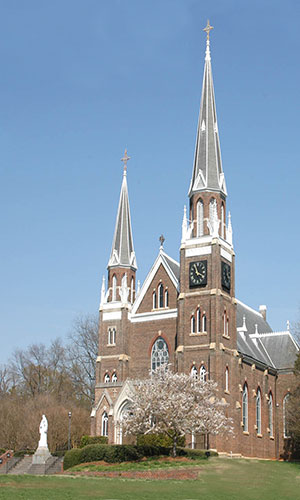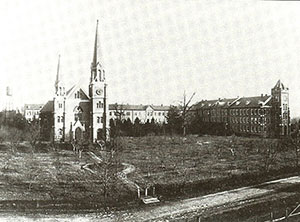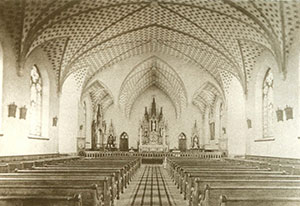 Pictured: Abbot Leo Haid, O.S.B., (center) is pictured in this 1910 photo with visiting abbots who had gathered for a nullius celebration at Belmont Abbey. (Diocese of Charlotte archives)BELMONT — A walk through the historic campus of Belmont Abbey College is lined with banners that read, "That in all things God may be glorified." Just inside Stowe Hall, the college administration building, sits a cross designed to illustrate the mission of the college: to show glory to God in the development of the whole person. In front of Stowe Hall a seal is painted on the ground which has the inscription "U.I.O.G.D" on it – which stands for the motto of Belmont Abbey College: "Ut in omnibus glorificetur Deus," meaning "That in all things God may be glorified."
Pictured: Abbot Leo Haid, O.S.B., (center) is pictured in this 1910 photo with visiting abbots who had gathered for a nullius celebration at Belmont Abbey. (Diocese of Charlotte archives)BELMONT — A walk through the historic campus of Belmont Abbey College is lined with banners that read, "That in all things God may be glorified." Just inside Stowe Hall, the college administration building, sits a cross designed to illustrate the mission of the college: to show glory to God in the development of the whole person. In front of Stowe Hall a seal is painted on the ground which has the inscription "U.I.O.G.D" on it – which stands for the motto of Belmont Abbey College: "Ut in omnibus glorificetur Deus," meaning "That in all things God may be glorified."
It is, then, no surprise, that Abbot Leo Haid, the founding abbot of Belmont Abbey, would characterize Benedictine education as a "thorough education."
Belmont Abbey College was founded as Saint Mary's College in 1876. At a cornerstone-laying ceremony for St. Mary's, Abbot Haid reflected the Benedictines' desire to thoroughly educate students when he proclaimed that the college was to be a place where students "will come in order to develop their mind as well as their body." It was important to the early monks that the college ensure that the students were "fitted for the world, and still more for the world to come."
The founding curriculum exemplified an education that would form moral, intelligent and well-rounded men by means of a Christian, liberal arts education.
The earliest course catalogue of the college (1889-1890) shows that the faculty and staff placed a strong emphasis on "the cultivation of the moral, no less than the intellectual and physical, faculties."
It was with these intentions that Benedictine monks from Saint Vincent Abbey in Pennsylvania opened Saint Mary's College (now named Belmont Abbey College). The monks were given a 506-acre farm in Gaston County. The donor was Father Jeremiah O'Connell, an Irish born circuit-riding priest who bought the auctioned land for $10 in cash. Father O'Connell gave the land to the Benedictines with two stipulations: First, that a Catholic boys' school be founded and maintained on the property. Second, according to the land deed, O'Connell reserved the right to have "his support, including clothing, during the term of his natural life and...a separate dwelling in a convenient location on the premises, the use of a horse (or mule) and buggy," the exclusive use of his chalice and other priestly paraphernalia, and "a weekly Mass...according to his intention."
Father Herman Wolf was the first Benedictine priest to arrive from Saint Vincent Abbey on April 21, 1876. He came with the school's first two students, and they began classes right away. By 1878, the college held its first commencement exercises. The new institution was placed under the patronage of Mary, Help of Christians in 1878 and would be elevated to the rank of abbey in 1884.
In 1892, Abbot Haid set out to build a cathedral on the property. But a year later, the project had run out of money. With the help of Father Francis Meyer, then pastor of St. Peter Church in Charlotte, he was able to secure a gracious donor: Mother Drexel (St. Katherine Drexel). Mother Drexel had one request, though: that the cathedral have an appropriate number of pews for the exclusive use of black people. During this time of segregation in the South, Abbot Haid told her he also recognized the importance of breaking "down the ugly prejudices against Colored people." In his letter to Mother Drexel, the abbot told her he saw "no reason why I should not gratefully accept your generous offer." The church, the most prominent building on campus, was completed in 1894.
When, in 1904, Mother Drexel visited Belmont Abbey, she found an entire row of pews running the length of the church for black worshippers.
Since the Abbey Church of Maryhelp was opened and desegregated, the monks no longer needed St. Benedict Church, the church built on the monks' property for black Catholics. The church was then converted to a school for the black children barred from the county's white-only schools. The Sisters of Mercy from Sacred Heart Convent taught the classes there, and the Abbey encouraged its students to assist with upkeep and groundskeeping of the site.
 The Sisters of Mercy of Belmont live at Sacred Heart Campus, near downtown Belmont. The sisters came to North Carolina prior to the arrival of the Benedictine monks. In 1892, they moved their motherhouse from eastern North Carolina to Belmont. Because Abbot Haid respected the sisters' reputation for hard and selfless work, he wished for them to join in the work of the monks in Belmont. In the early 1900s the sisters began a school for girls that became Sacred Heart College. Though Sacred Heart College closed in 1987 and merged with Belmont Abbey College, the sisters have continued to carry out many works of service for those who are sick, poor or uneducated.
The Sisters of Mercy of Belmont live at Sacred Heart Campus, near downtown Belmont. The sisters came to North Carolina prior to the arrival of the Benedictine monks. In 1892, they moved their motherhouse from eastern North Carolina to Belmont. Because Abbot Haid respected the sisters' reputation for hard and selfless work, he wished for them to join in the work of the monks in Belmont. In the early 1900s the sisters began a school for girls that became Sacred Heart College. Though Sacred Heart College closed in 1987 and merged with Belmont Abbey College, the sisters have continued to carry out many works of service for those who are sick, poor or uneducated.
 Belmont Abbey College was named Saint Mary's College at the request of Father O'Connell. At the school's first alumni reunion in 1913, Abbot Haid announced the name change. Though, he said, Mary Help of Christians would continue to be recognized as the principal patron of the college and monastery, the school's name was changed to Belmont Abbey College.
Belmont Abbey College was named Saint Mary's College at the request of Father O'Connell. At the school's first alumni reunion in 1913, Abbot Haid announced the name change. Though, he said, Mary Help of Christians would continue to be recognized as the principal patron of the college and monastery, the school's name was changed to Belmont Abbey College.
Following the Second Vatican Council, the worn-out and dilapidated interior of the Abbey church was renovated, in accordance to the liturgical reforms of the era. Shortly after, Belmont Abbey lost its territorial status and cathedral rank to the newly-created Diocese of Charlotte. In 1998, Pope John Paul II named the Abbey church a minor basilica.
In 1967, Father John Oetgen, college president and Benedictine monk, conferred an honorary doctorate degree on the Protestant evangelist Billy Graham. Graham's visit was, at the time, seen as a bold ecumenical gesture. The statement about Christian unity surprised both Catholics and Protestants as it was a forward-looking gesture on both parts. Graham called it "a time when Protestants and Catholics could meet together and greet each other as brothers, whereas 10 years ago they could not."
The campus regularly has visitors who come to enjoy the beautiful historic campus, the worship services in the basilica and the official pilgrimage shrine, the Grotto of Our Lady of Lourdes. Built in 1891, the grotto also includes a Shrine of St. Walburga that was added the same year in honor of the secondary patroness of the monastery.
When visitors walk into the basilica, they first see a prominent baptismal font – a granite block that is one of the oldest landmarks on campus. According to tradition, the stone had been an altar for Native Americans and later a block upon which slaves were auctioned off. Abbot Walter Coggin proposed the adaptation of the stone into a baptismal font. It now has a plague which reads, "Upon this rock, men once were sold into slavery. Now upon this rock, through the waters of baptism, men become free children of God."
— Christopher Lux, correspondent
 More resources online
More resources online
History of the Diocese of Charlotte: www.charlottediocese.org/history
This date in history in the Diocese of Charlotte: www.charlottediocese.org/ministries-a-departments/archives
Editor's note: The Diocese of Charlotte was founded on Jan. 12, 1972. To celebrate the 40th anniversary of the diocese and the history of the Church in western North Carolina, this year-long series spotlights the people who built up the Church, the major developments over the past 40 years, and what changes could be in store for the future.



 More resources online
More resources online